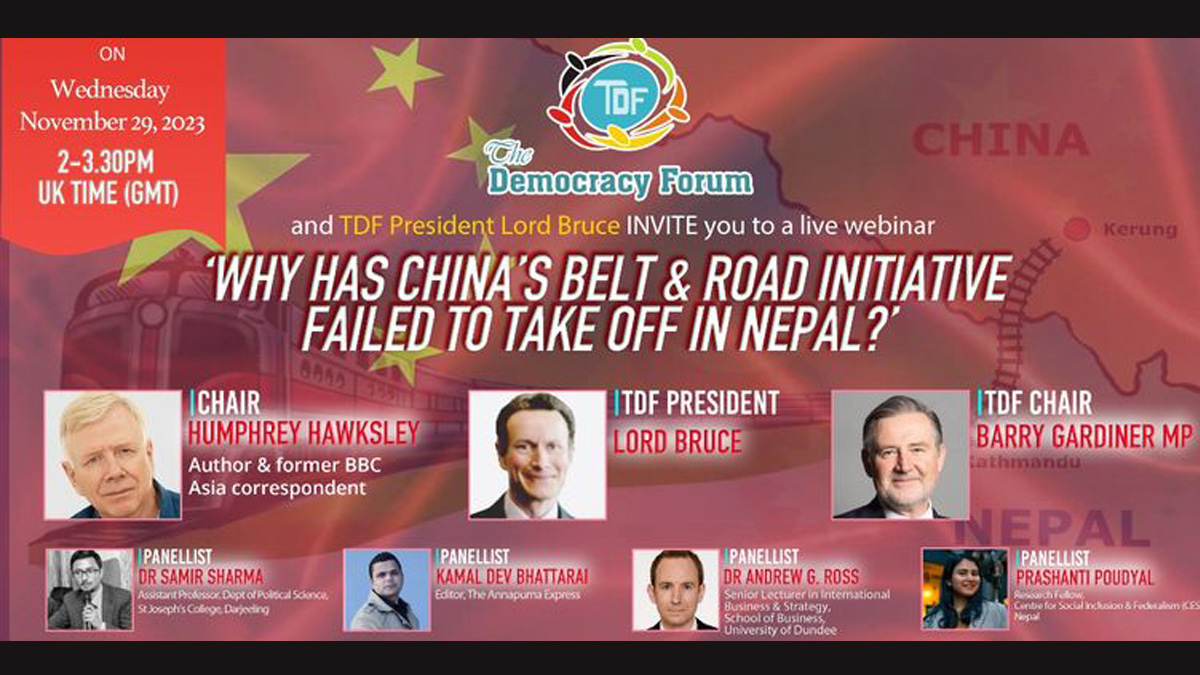
The Democracy Forum Webinar: Decoding China’s Belt and Road Initiative Puzzle in Nepal
In a recent webinar hosted by The Democracy Forum, the spotlight turned towards Nepal as experts delved into the intriguing question of why China’s Belt and Road Initiative (BRI) has failed to gain traction in the Himalayan nation, despite its initial enthusiasm.
Founded in 2009, The Democracy Forum, a not-for-profit organization, organized a thought-provoking discussion led by Humphrey Hawkesly, exploring the challenges and complexities surrounding China’s ambitious infrastructure project in Nepal.
Background: The Curious Case of Nepal and the BRI
Nepal officially joined China’s Belt and Road Initiative in 2017, marking a significant step in its quest for enhanced infrastructure and economic development. However, six years later, the outcomes are far from what was anticipated.
The webinar opened with a recap of recent events, including Nepal’s Foreign Minister’s clarification in June that not a single project under the BRI had been executed, refuting China’s claim of the Pokhara International Airport as the flagship project. Furthermore, after an eight-day visit to China by Nepal’s Prime Minister in September, none of the 12 Memoranda of Understandings (MOUs) signed were under the BRI framework.

The Panel and Their Insights
The webinar brought together a distinguished panel comprising Humphrey Hawkesly, Barry Gardiner, Dr. Andrew G Ross, Dr. Samir Sharma, Kamal Dev Bhattrai, and Prashanti Poudyal. Each panelist provided unique perspectives on the reasons behind the stagnation of the BRI in Nepal.
Lord Bruce, the President of The Democracy Forum, set the stage by providing historical context. He highlighted Nepal’s intricate diplomatic relationships with China and India, emphasizing the challenges faced by the nation in pursuing foreign policy objectives without causing offense to major power.
Lord Bruce also discussed the Millennium Challenge Corporation Nepal compact (MCC), a grant of $500 million from the United States for infrastructure projects. The MCC raised questions about Nepal’s alignment in the global geopolitical landscape, caught between the interests of the U.S., China, and India.
Nepal’s Perspective: Caught in a Geopolitical Quagmire
The complexity of Nepal’s geopolitical position was underscored during the webinar. Nepal’s hesitation to fully commit to the BRI was attributed to fears of undermining its constitutional requirement of non-alignment. Ganesh Adhikari, a former Nepal chief of National Investigation Department, noted that the country sees the BRI not as an umbrella initiative but as specific projects, leading to a reluctance to fully embrace the comprehensive engagement China envisions.
Conclusion: A Geopolitical Chessboard
The webinar concluded with the acknowledgment that Nepal finds itself strategically placed but entangled in a geopolitical chessboard involving the U.S., China, and India. The struggle to balance political interests while maintaining a non-aligned foreign policy has hindered the execution of BRI projects.
As the Democracy Forum continues to facilitate insightful discussions, the case of Nepal serves as a microcosm reflecting broader geopolitical intricacies surrounding China’s Belt and Road Initiative.
Why BRI Faces Hurdles in Nepal
In a recent webinar hosted by The Democracy Forum, experts discussed the persistent challenges hindering the successful implementation of China’s Belt and Road Initiative (BRI) in Nepal. The key issues revolve around funding, economic reforms, and political instability.
Funding Modalities: A Major Stumbling Block
The first major obstacle flagged in the discussion was the issue of funding. China’s BRI loans come with higher interest rates compared to loans from other multilateral organizations. According to data from the College of William and Mary, the average interest rate for BRI projects is 4.2%, with a short grace period and repayment period. This makes the funding modality less favorable for Nepal.
Inadequate Economic Reforms Impact Investment Atmosphere
Nepal’s insufficient economic reforms were identified as another critical factor hampering the success of the BRI. The anticipated investment atmosphere has not materialized due to these economic limitations, creating a challenging environment for the implementation of infrastructure projects.
Political Instability: A Lingering Concern
Political instability, a long-standing issue in Nepal, emerged as the third major hurdle. The country’s history of civil unrest and political transitions has created an uncertain environment, impacting the execution of projects under the BRI. The political situation has been a source of concern for both domestic and international stakeholders.
Chinese Interference and Financial Risks
Experts highlighted the potential risks for Nepal, warning that Chinese interference might lead to financial disaster, drawing parallels with the situation in Sri Lanka. The fear is that if Nepal continues down this path, it could face economic challenges similar to those experienced by other nations involved in large-scale Chinese infrastructure projects.
The Complexity of BRI Implementation
Responding to concerns, the panelists emphasized the need to assess each case individually rather than drawing direct comparisons between countries. The massive scale of the BRI projects makes it challenging to generalize outcomes, and Nepal might be adopting a more cautious and strategic approach in light of its specific needs and requirements.
Nepal’s Strategic Approach
Kamal Dev Bhattarai, an editor at the Annapurna Express, shed light on how Nepal perceives and engages with the BRI. He noted that Nepal is cautious about taking high-interest loans for major infrastructure projects, learning from the experiences of other countries, including the issues faced by Pokhara International Airport.
Political Parties’ Perspectives on BRI
Kamal Dev Bhattarai pointed out that political parties in Nepal either lack a clear understanding of the BRI or pretend not to comprehend its nature. There is a tendency among some leaders to view BRI as a form of grand assistance, whereas, in reality, it involves taking loans from Chinese banks, which requires careful consideration of the associated financial implications.
US Grant and Geopolitical Dynamics
The $500 million grant to Nepal from the United States under the Millennium Challenge Corporation (MCC) was mentioned as a potential source of tension between China and Nepal. The speakers indicated that while China opposed the MCC project, it might be seeking a level playing field, asserting its interests in the face of perceived pressure from other major powers.
Nepal’s Reluctance and Financial Feasibility
Prashanti Poudyal, a Research Fellow, emphasized that Nepal’s reluctance to embrace the BRI stems from financial feasibility issues. The country is unable to afford high-interest loans for significant infrastructure projects, leading to a cautious and strategic approach by Nepali leaders.
In conclusion, the webinar highlighted the multifaceted challenges facing Nepal in the successful execution of the Belt and Road Initiative. The nuanced discussion provided valuable insights into the economic, political, and strategic considerations influencing Nepal’s stance on BRI projects.















Comments